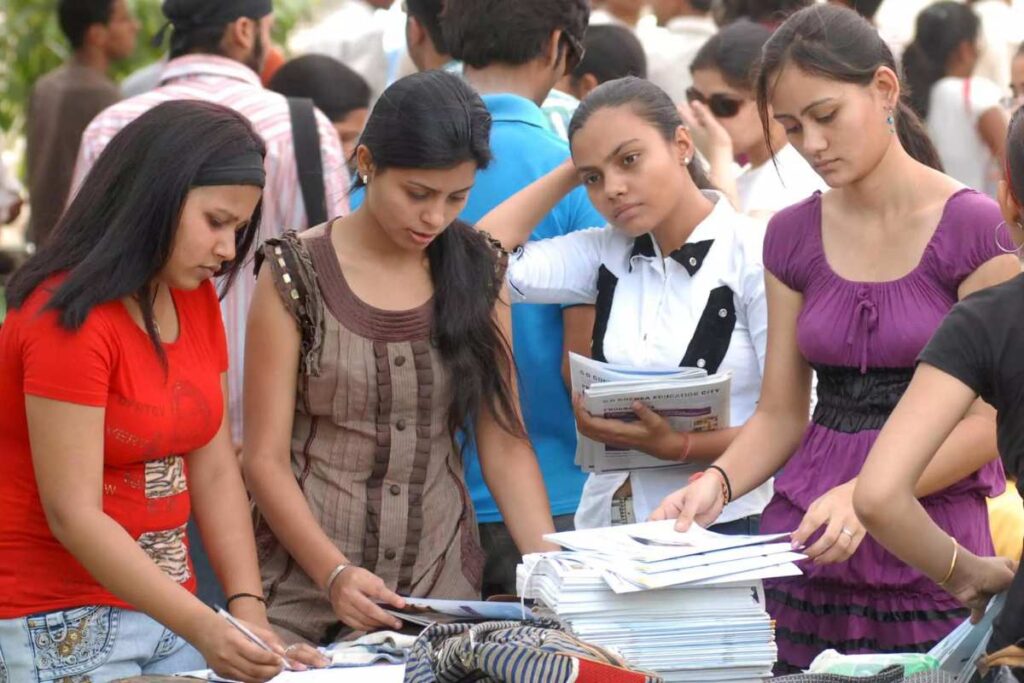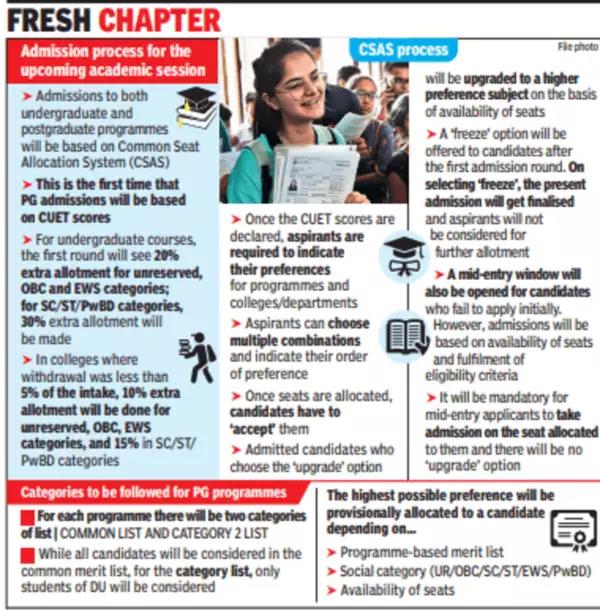It is one of the significant developments, the University of Delhi (DU) has recently made it mandatory for all postgraduate students(PG) required to take the (CUET) for a DU berth to secure a seat in the university. In this article, we will explore the implications of the CUET entrance test for PG and discuss its potential impact on both the students and the university.
If a student plans to pursue post-graduation (PG) from a reputed college of Delhi University then he compulsorily has to appear for the newly launched CUET entrance test for PG. And admission will be based on scores of that test only.
The introduction of CUET for postgraduate admissions marks a departure from the previous system, which primarily relied on academic merit and interviews. Under the new policy, all postgraduate aspirants will be required to appear for the CUET, a standardized entrance test designed to assess their aptitude and knowledge in their respective fields of study. This test will consist of only MCQs, that is, multiple-choice questions.
This decision comes as part of the university’s efforts to streamline the admission process for PG students and ensure fair and transparent selection criteria for its postgraduate programs.
The University is also considering making a 20% additional allotment of seats for the Unreserved category, EWS and OBC Categories as well. And for the ones from SC/ST category, the expected additional allotment will range up to 30% in the first round.

Also, the proposed policy mentions that in the case of the colleges where the withdrawals are 5% less than intake, only and only for those colleges the additional allotment of seats will be less.
The exact numbers for additional allotment of seats in case of colleges where withdrawal are 5% less than intakes are 10% additional seats will be allotted to unreserved, EWS and OBC categories and 15% additional seats will be allotted to SC/ST and Pwbd categories.
How will the Seats be Allotted to PG Students?
This is the first time when PG admissions will be based on CUET results, the seats to students that are college and course will be allocated to them based on CSAS, which is the Common Seats Allocation System.

Here in this system, students will be required to fill in their preferences for college and course, and based on their results they will finally get their final colleges. All this process of CSAS will start once the results are out. The whole system is briefed here under:
- Firstly based on the scores obtained by students in CUET, they will be allotted a particular college and course based on their merit and then the students will be required to “Accept” the same and “freeze” it if they are satisfied with their current college and course allotted. But in case they are not, they will have to “Upgrade”.
Here obviously the student who fills more and more combinations of college & courses will get more benefits and will ultimately have a higher probability of getting his/her desired combination.
- The order filled by students will determine the final allocation of seats. And the CSAS is designed such that the final seat allotted to the student will be in his best interest if he has filled his preference order correctly.
- The candidates will be automatically allotted the best course-college combination they have filled considering all their social class, scores, whether they are already from university or not and factors like that.
- The candidates will be required to check for the “Upgrade” option in each round of allocation of seats that takes place. If a student by mistake misses to check for upgrades then it will be solely his/her fault and all grievances of this type will not be entertained, also as a result he will no longer be allowed to sit in the upgrade option.
- Also, since these preferences filled by students are very important, all the candidates must ensure that the preferences filled by them are correct and that they will confirm before clicking on the “submit” button on the last day of the second phase, the “Preference filling phase”.
Any changes or alterations or reorder they wish to make in the preference list can only be made before the last day and not after that.
DU Old PG Admission Process
Before this CUET entrance test for PG, the admissions were based on the DUET (DU Entrance Test) conducted, in that system the students from DU itself were considered based on their scores in DUET and 50% of the total seats were reserved for DU graduates only, while this pattern is same as before only that is still 50% of the seats are reserved for DU graduates.
For allocation of seats, two categories will be made, those from DU will still be able to apply under the 50% reserved seats for University students, but that won’t mean that they will be exempted from giving exams (CUET) like earlier years. And the policy of getting these students admitted just based on graduation marks will end from now, as per the new proposed policy.
Benefits of the CUET Entrance Test for PG
The launching of the CUET system has a lot of advantages, one is that it has standardized and streamlined the whole admission process and resulted in simpler systems. Also here all the students whether already from DU or not from DU all have to appear for CUET, that is all Postgraduate Students are required to take CUET for DU Berth, unlike the old systems.
The various benefits like “Objective Selection Process” and “Fairness and Transparency”, also other than these mentioned CUET has benefits for the aspiring PG students as well like Career Prospects or be it more Networking Opportunities. All these have been elaborated on here:
Objective Selection Process
By introducing CUET, the University of Delhi aims to establish an objective and standard as All Postgraduate Students are Required to Take CUET for DU Berth. This move is expected to provide equal opportunities to all students, irrespective of their academic background or institution of origin.
The test will not only evaluate the candidates’ subject-specific knowledge but also their critical thinking, problem-solving abilities, and overall aptitude.
Fairness and Transparency
One of the key advantages of implementing CUET is the increased transparency and fairness in the admission process. With a standardized test, the evaluation becomes more objective and eliminates potential biases associated with subjective measures like interviews.
This new system of CUET entrance test for PG will ensure that deserving candidates secure their berths solely based on merit, enhancing the credibility and reputation of the University of Delhi’s postgraduate programs.
Networking Opportunities
Being a reputed institution, CUET provides excellent networking opportunities for PG students. They can interact with fellow students, faculty members, alumni, and professionals from different industries during seminars, conferences, and workshops. This enables students to build valuable connections and broaden their professional network.
Conclusion
The introduction of the CUET entrance test for PG admissions at the University of Delhi represents a significant shift towards a more standardized and objective selection process.
While it may pose challenges initially, the move is expected to ensure fairness, transparency, and equal opportunities for all students.
Also, the candidates need to correctly understand how the whole CUET system will work so that they do not commit a mistake either while understanding the new pattern or maybe while filling their course college combination preference because these mistakes can cost them a lot later on.
Aspiring postgraduate students should embrace this change and hope that their efforts bring fruitful results and they ultimately secure their place in one of India’s most prestigious universities.
DU Squad is the only one-stop platform on the internet providing updates about anything and everything related to the University of Delhi.















